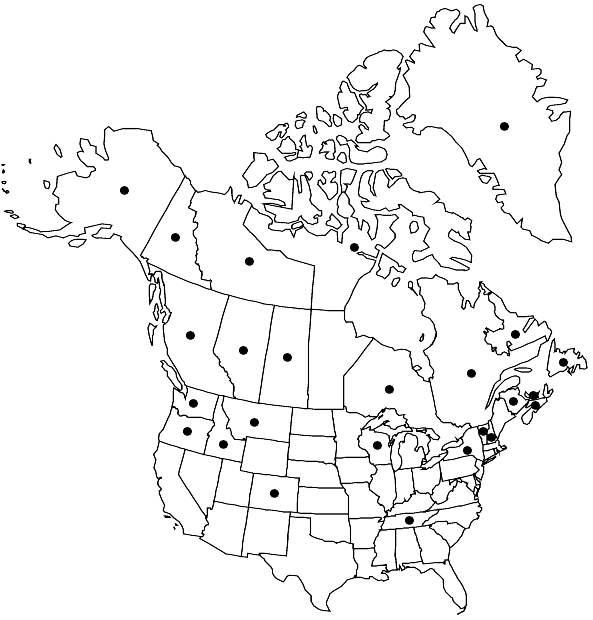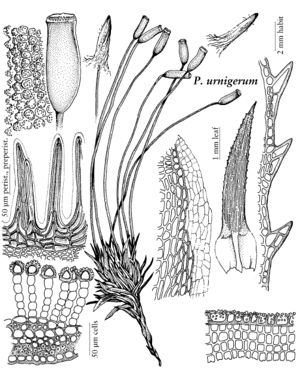Pogonatum urnigerum
Prodr. Aethéogam., 84. 1805,.
Plants medium to robust, in loose tufts or scattered among other mosses, green to glaucous green, brownish with age. Stems 2–5 cm, commonly branching by innovations, frequently dendroid. Leaves 2.5–6 mm, densely imbricate and crowded toward the stem and branch tips, erect-appressed and somewhat incurved when dry, reflexed and widely spreading when moist, gradually to rather abruptly contracted to the blade, the hinge-cells sharply differentiated; sheath ovate to obovate, hyaline-margined on the flanks, with a wedge of incrassate hinge-cells at the shoulders and extending a short distance up the blade margin; blade broadly oblong-lanceolate to narrowly linear-lanceolate, only slightly concave, toothed from apex almost to the shoulders, or sometimes subentire; costa percurrent or slightly excurrent as a subulate, serrate to smooth point, smooth abaxially or sparingly toothed towards the tip; lamellae 30–46, entire in profile, 4–7 cells high, the marginal cells enlarged, thick-walled and coarsely papillose, in section rounded to elliptical, broader than high, the distal wall broadly convex, the lumen rounded-pentagonal; sheath cells short-rectangular to ± isodiametric approaching the blade; cells on abaxial surface of blade 24–27 µm, irregularly quadrate, ± isodiametric, thick-walled, the transverse walls often thicker. Seta 1–4 cm, typically one per perichaetium but several per plant at the tips of branches. Capsule 2–3 mm, short-cylindric to ovate-cylindric, erect to inclined, light-brown to reddish-brown to blackish with age; exothecium mammillose, densely areolate, the cells rounded-quadrate, incrassate, with slitlike pits in the outer wall; peristome 300–350 µm, divided to 0.6, the teeth rather broad, reddish-brown with hyaline margins. Spores 10–18 µm.
Habitat: Disturbed sandy or gravelly soil on stream banks, roadsides, crevices of cliffs and boulders, and in late snow areas
Elevation: moderate to high elevations
Distribution

Greenland, Alta., B.C., N.B., Nfld. and Labr., N.W.T., N.S., Nunavut, Ont., P.E.I., Que., Sask., Yukon, Alaska, Colo., Idaho, Mont., N.H., N.Y., Oreg., Tenn., Vt., Wash., Wis., Europe, Caucasus, Siberia, e Asia (Philippines), e Asia (New Guinea.), Atlantic Islands (Iceland)
Discussion
The most widely distributed species of the genus, Pogonatum urnigerum is notably absent from Middle America and south-temperate South America. In Nunavut, it is known from Baffin, Ellesmere, and Melville islands. The plants are usually more robust than are those of P. dentatum, often repeatedly branched, and the crowding of the leaves at the tips of the branches produces a distinctive tiered effect. The marginal cells of the lamellae are rounded in section, and the lumen is pentagonal, resembling the gable end of a house. Fruiting plants of the two species can be easily distinguished also by the peristome, which in P. dentatum is deeply divided almost to the base. Polytrichastrum alpinum also branches repeatedly, but the plants are generally larger and absent the bluish glaucous appearance characteristic of P. urnigerum in the field.
Selected References
None.
Lower Taxa
"um" is not declared as a valid unit of measurement for this property."broadened" is not a number."elongated" is not a number."um" is not declared as a valid unit of measurement for this property. "um" is not declared as a valid unit of measurement for this property."broad" is not a number.
